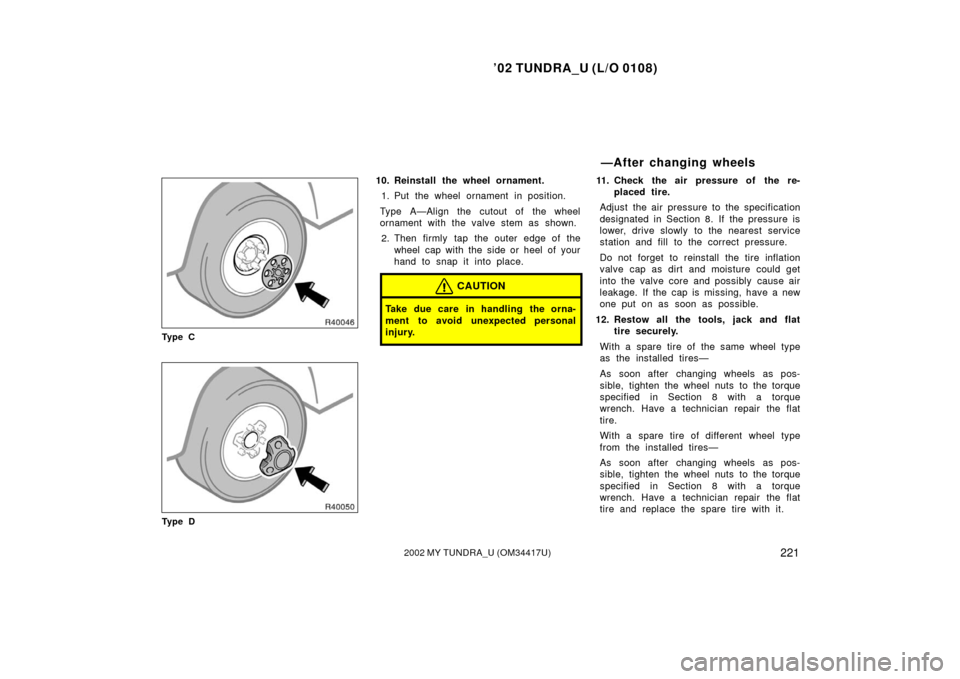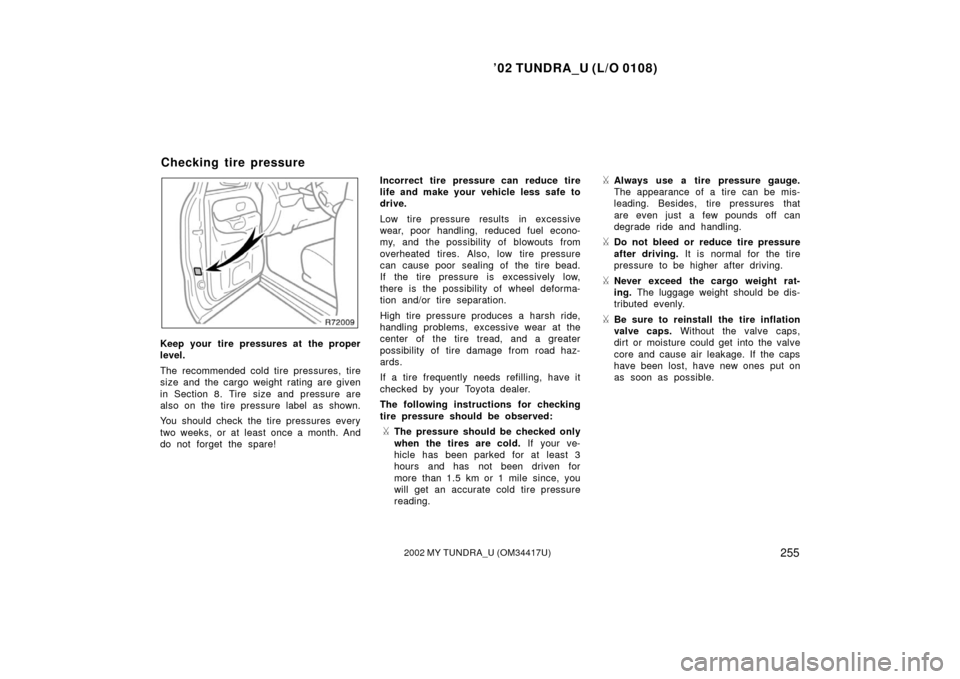Page 211 of 299

’02 TUNDRA_U (L/O 0108)
2042002 MY TUNDRA_U (OM 34417U)
Improving fuel economy is easy—just take
it easy. It will help make your vehicle last
longer, too. Here are some specific tips
on how to save money on both fuel and
repairs:
�Keep your tires inflated at the cor-
rect pressure. Underinflation causes
tire wear and wastes fuel. See Section
7�2 for instructions.
�Do not carry unneeded weight in
your vehicle. Excess weight puts a
heavier load on the engine, causing
greater fuel consumption.
�Avoid lengthy warm�up idling. Once
the engine is running smoothly, begin
driving—but gently. Remember, howev-
er, that on cold winter days this may
take a little longer.
�Always keep the automatic transmis-
sion overdrive switch turned on.
Driving with the overdrive switch off
will reduce the fuel economy. (For de-
tails, see “Automatic transmission” in
Section 1�6.)
�Accelerate slowly and smoothly.
Avoid jackrabbit starts. Get into high
gear as quickly as possible.
�Avoid long engine idling. If you have
a long wait and you are not in traffic,
it is better to turn off the engine and
start again later.
�Avoid engine lugging or over�rev-
ving. Use a gear position suitable for
the road on which you are travelling.
�Avoid continuous speeding up and
slowing down. Stop�and�go driving
wastes fuel.
�Avoid unnecessary stopping and
braking. Maintain a steady pace. Try
to time the traffic signals so you only
need to stop as little as possible or
take advantage of through streets to
avoid traffic lights. Keep a proper dis-
tance from other vehicles to avoid sud-
den braking. This will also reduce wear
on your brakes.
�Avoid heavy traffic or traffic jams
whenever possible.
�Do not rest your foot on the clutch
or brake pedal. This causes premature
wear, overheating and poor fuel econo-
my.
�Maintain a moderate speed on high-
ways. The faster you drive, the greater
the fuel consumption. By reducing your
speed, you will cut down on fuel con-
sumption.
�Keep the front wheels in proper
alignment. Avoid hitting the curb and
slow down on rough roads. Improper
alignment not only causes faster tire
wear but also puts an extra load on
the engine, which, in turn, wastes fuel.
�Keep the bottom of your vehicle free
from mud, etc. This not only lessens
weight but also helps prevent corro-
sion.
�Keep your vehicle tuned�up and in
top shape. A dirty air cleaner,
improper valve clearance, dirty plugs,
dirty oil and grease, brakes not
adjusted, etc. all lower engine
performance and contribute to poor fuel
economy. For longer life of all parts
and lower operating costs, keep all
maintenance work on schedule, and if
you often drive under severe
conditions, see that your vehicle
receives more frequent maintenance.
(For scheduled maintenance informa-
tion, please refer to the “Scheduled
Maintenance Guide” or “Owner ’s
Manual Supplement”).
How to save fuel and make
your vehicle last longer
Page 228 of 299

’02 TUNDRA_U (L/O 0108)
2212002 MY TUNDRA_U (OM 34417U)
Ty p e C
Ty p e D
10. Reinstall the wheel ornament.
1. Put the wheel ornament in position.
Type A—Align the cutout of the wheel
ornament with the valve stem as shown. 2. Then firmly tap the outer edge of the wheel cap with the side or heel of your
hand to snap it into place.
CAUTION
Take due care in handling the orna-
ment to avoid unexpected personal
injury.
11. Check the air pressure of the re- placed tire.
Adjust the air pressure to the specification
designated in Section 8. If the pressure is
lower, drive slowly to the nearest service
station and fill to the correct pressure.
Do not forget to reinstall the tire inflation
valve cap as dirt and moisture could get
into the valve core and possibly cause air
leakage. If the cap is missing, have a new
one put on as soon as possible.
12. Restow all the tools, jack and flat tire securely.
With a spare tire of the same wheel type
as the installed tires—
As soon after changing wheels as pos-
sible, tighten the wheel nuts to the torque
specified in Section 8 with a torque
wrench. Have a technician repair the flat
tire.
With a spare tire of different wheel type
from the installed tires—
As soon after changing wheels as pos-
sible, tighten the wheel nuts to the torque
specified in Section 8 with a torque
wrench. Have a technician repair the flat
tire and replace the spare tire with it.
—After changing wheels
Page 262 of 299

’02 TUNDRA_U (L/O 0108)
2552002 MY TUNDRA_U (OM 34417U)
Keep your tire pressures at the proper
level.
The recommended cold tire pressures, tire
size and the cargo weight rating are given
in Section 8. Tire size and pressure are
also on the tire pressure label as shown.
You should check the tire pressures every
two weeks, or at least once a month. And
do not forget the spare! Incorrect tire pressure can reduce tire
life and make your vehicle less safe to
drive.
Low tire pressure results in excessive
wear, poor handling, reduced fuel econo-
my, and the possibility of blowouts from
overheated tires. Also, low tire pressure
can cause poor sealing of the tire bead.
If the tire pressure is excessively low,
there is the possibility of w
heel deforma-
tion and/or tire separation.
High tire pressure produces a harsh ride,
handling problems, excessive wear at the
center of the tire tread, and a greater
possibility of tire damage from road haz-
ards.
If a tire frequently needs ref illing, have it
checked by your Toyota dealer.
The following instructions for checking
tire pressure should be observed:
�The pressure should be checked only
when the tires are cold. If your ve-
hicle has been parked for at least 3
hours and has not been driven for
more than 1.5 km or 1 mile since, you
will get an accurate cold tire pressure
reading.
�Always use a tire pressure gauge.
The appearance of a tire can be mis-
leading. Besides, tire pressures that
are even just a few pounds off can
degrade ride and handling.
�Do not bleed or reduce tire pressure
after driving. It is normal for the tire
pressure to be higher after driving.
�Never exceed the cargo weight rat-
ing. The luggage weight should be dis-
tributed evenly.
�Be sure to reinstall the tire inflation
valve caps. Without the valve caps,
dirt or moisture could get into the valve
core and cause air leakage. If the caps
have been lost, have new ones put on
as soon as possible.
Checking tire pressure